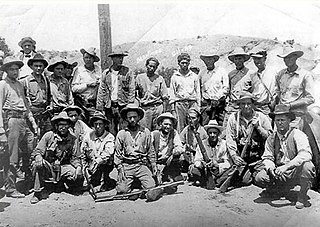A sheriff is a government official, with varying duties, existing in some countries with historical ties to England where the office originated. There is an analogous, although independently developed, office in Iceland that is commonly translated to English as sherif.

A bailiff is a manager, overseer or custodian – a legal officer to whom some degree of authority or jurisdiction is given. Bailiffs are of various kinds and their offices and duties vary greatly.
Marshal is a term used in several official titles in various branches of society. As marshals became trusted members of the courts of Medieval Europe, the title grew in reputation. During the last few centuries, it has been used for elevated offices, such as in military rank and civilian law enforcement.

In the United States, a sheriff is the chief of law enforcement of a county. Sheriffs are usually either elected by the populace or appointed by an elected body.

The Anne Arundel County Sheriff's Office (AASO) is the law enforcement arm of the court, serving the citizens of Anne Arundel County, Maryland. All deputy sheriffs are certified law enforcement officials with full authority of arrest.

The Allegany County Sheriff's Office (ACSO) is the primary law enforcement agency for Allegany County, Maryland. The ACSO is a nationally accredited law enforcement agency servicing 430 square miles (1,100 km2) and a population of 75,300.

The Baltimore County Sheriff's Office (BCoSO) is a Sheriff's Office in Baltimore County, Maryland, US, and the secondary law enforcement agency of the County (after the Baltimore County Police Department) which provides protection for the Baltimore County Courthouse in Towson, Maryland. The Baltimore County Sheriff's Office is one of the oldest sheriff's offices in existence in the State of Maryland, dating back to 1659, the year of the County's founding.

The Calvert County Sheriff's Office (CCSO) is the primary law enforcement agency servicing over 87,000 residents and 213 square miles (550 km2) in Calvert County, Maryland.

The posse comitatus, frequently shortened to posse, is in common law a group of people mobilized by the conservator of peace – typically a reeve, sheriff, chief, or another special/regional designee like an officer of the peace potentially accompanied by or with the direction of a justice or ajudged parajudicial process given the imminence of actual damage – to suppress lawlessness, defend the people, or otherwise protect the place, property, and public welfare. The posse comitatus as an English jurisprudentially defined doctrine dates back to ninth-century England and the campaigns of Alfred the Great simultaneous thereafter with the officiation of sheriff nomination to keep the regnant peace. There must be a lawful reason for a posse, which can never be used for lawlessness.

The Carroll County Sheriff's Office (CCSO) was created in 1837 and is the primary law enforcement agency for Carroll County, MD. It services a population of 170,260 people within 449.13 square miles.

The Frederick County Sheriff's Office (FCSO) is the primary law enforcement agency serving a population of 222,938 residents within the 662.88 square miles (1,717 km2) area of Frederick County, Maryland.
The Cecil County Sheriff's Office (CCSO) is the primary law enforcement agency servicing a population of more than 100,000 people within Cecil County, Maryland's 348.13 square miles (901.7 km2). The CCSO was established in 1674 and is responsible for the protection of life and property, enforcing orders of the court, and maintaining the detention facility for Cecil County.

The Howard County Sheriff's Office (HCSO) is a law enforcement organization which acts as the enforcement arm of the Howard County court system and services Howard County, Maryland, population 328,200. Its mission centers around providing judicial enforcement and physical security for the Circuit Court. The department is a secondary law enforcement agency as police services are mostly provided by the larger, better-known Howard County Police Department while the county jail is run by the Howard County Department of Corrections. However, Sheriff's deputies are fully certified law enforcement officers with the same authority as any police officer in the state of Maryland. They assist county police officers with calls for service when requested or needed.

The Cook County Sheriff's Office is the principal law enforcement agency that serves Cook County, Illinois. It is the second largest sheriff's department in the United States, with over 6,900 members when at full operational strength. It is headed by the Cook County Sheriff, currently Thomas Dart.

The Alberta Sheriffs Branch is a provincial law enforcement agency overseen by the Ministry of Public Safety and Emergency Services of the province of Alberta, Canada. Under the authority of the Peace Officer Act, Alberta Sheriffs are provincial peace officers with jurisdiction over the province of Alberta. The premier of Alberta has the authority to grant emergency police powers to all Alberta sheriffs during major emergencies within the province. The Alberta Sheriffs Branch is the largest sheriff service in Canada.

The Prince George's County Sheriff's Office (PGSO), officially the Office of the Sheriff, Prince George's County, provides law enforcement services in Prince George's County, Maryland in the United States. Its headquarters are located in Upper Marlboro, near the Depot Pond. The sheriff is the chief law enforcement officer of Prince George's County and is elected every four years. There are no term limits for the sheriff.
The County sheriff (Florida) is a Florida constitutional officer and a part of the state judicial branch.

The Allegheny County Sheriff's Office is a law enforcement agency that serves Allegheny County, Pennsylvania, and is the largest sheriff's office in the state. The ACSO serves as a local arm of the Pennsylvania Unified Judicial System in a number of roles, including: court security, writ services, sales, prisoner transportation, issuing of firearm licenses and execution of warrants. A primary responsibility of the office is fugitive apprehension. The Sheriff's Office also assists local law enforcement agencies with emergency and incident response on an as-needed basis, most notably through the use of trained police canines.
In the United States, there is no consistent use of the office of constable throughout the states; use may vary within a state. A constable may be an official responsible for service of process: such as summonses and subpoenas for people to appear in court in criminal and/or civil matters. They can also be fully empowered law enforcement officers. Constables may have additional specialized duties unique to the office. In some states the constable is an elected or appointed position at the state or local level of local government. Their jurisdiction can vary from statewide to county/parish and local township boundaries based on the state's laws.

The Office of the High Sheriff of Newfoundland and Labrador is a provincial law enforcement agency overseen by the Minister of Justice and Public Safety in the province of Newfoundland and Labrador, Canada. Founded in 1729, it is the oldest law enforcement agency in Canada. Sheriffs are provincial peace officers appointed under the Sheriff's Act, 1991 with authority to enforce all relevant federal and provincial acts including the criminal code throughout Newfoundland and Labrador while in the lawful execution of their duties.
















